#pagan calendar
Text

✷ welcome February ~ with Imbolc from the #wheeloftheyear 🐑 🤍✨

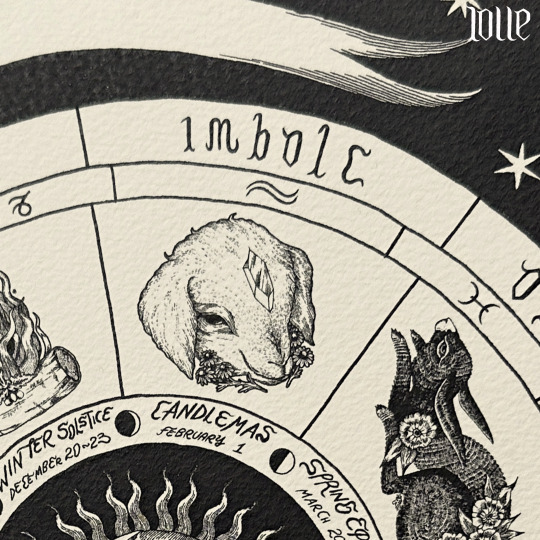
👉🏻 you can find this illustration included on my "Wheel of the Year" art print || currently available on my shop 🌿✨
Imbolc ~ original ink illustration from the series "Wheel of the Year" ©Lolle (2023)
#imbolc#wheel of the year#pagan calendar#loll3#illustration#loll3art#art#ink on paper#ink illustration#lamb
45 notes
·
View notes
Text
My Slavic Polytheist Calendar
Every Slavic Polytheist will have their own calendar constructed based on where they are from, what deities they worship, and any number of other personal preferences they may have. As such, beginners will often find themselves incredibly confused on where to start, which either leads to decision paralysis or trying to shoehorn Slavic traditions into the Wiccan wheel of the year, which doesn't usually go well because of the very different nature of these two practices, no matter how syncretic one of them tries to be.
With this in mind, I've decided to share the calendar I use in my practice on my blog and my TikTok, though this will have more detail than the video. It's important to note, though, that my calendar takes my needs and preferences into account above all else. This means that it is primarily influenced by Carpatho-Rusyn Orthodox traditions, the ADF's calendar, common East Slavic celebrations, and a combination of Lemko and American traditions.
❆ Winter ❆
January 7 - Epiphany
It's Christmas, except your dad might go outside and threaten any trees that didn't bear fruit last harvest with an axe and you might summon a demon to see what your future husband looks like. You will also stack bread in a mountain at the end of your dinner table in hopes of bringing prosperity into the upcoming year.
January 8 - Fašengy Begins
To be totally honest, the dating on this holiday is confusing as all get out. It's essentially a Slavic Mardi Gras but, depending who you ask, it can also simply be the season where a lot of people in your community get married and/or start having children. I mark this date because that's when the marrying and child rearing begins, but Fašengy festivities in Rusyn communities typically don't start until the day after Epiphany and ends on Ash Wednesday, when Lent starts. During these festivities, you would eat, drink, be merry, and try to get married.
January 13 - Malanka
New Year's Eve celebrations. Prepare for a small army of children to wish you well in the morning. If you're a laborer, enjoy the day off but also worry about your contract being renewed.
January 14 - New Year's Day
Continuation of well wishes and repeating your wishes from Christmas in hopes that they come true in the upcoming year.
February 1 - Winter-Cross Quarter on the ADF's Calendar
Much like New Years, its time to begin establishing your wishes and vision for the upcoming year while shedding the old year.
February 11 - Veles' Day or the Festival of Veles
Sometimes celebrated on the 24th of February, Veles is venerated on the same date(s) as Saint Blaise, an Orthodox and Catholic saint that Veles has become syncretized with because of their shared patronage of flocks and herds. In neopolytheist communities, it is common for Veles to be offered milk and ritual fights will be organized. It is taboo to eat veal on this holiday, as Veles is being asked for protection of herds, including cattle.
❀ Spring ❀
March 11 - Maslenitsa Begins
Maslenitsa aligns with the last week of Fašengy as the last week before Lent. In some cases, this week is treated as the final goodbye to winter, in others, that doesn't happen until later on in the year. During Maslenitsa, it's customary to make blini, dance, sing, and generally indulge in any distractions of your choosing before the more reflective season of Lent begins. Each day of Maslenitsa is dedicated to different activities, family bonding, snowball fights, sleigh rides, and more
March 17 - Maslenitsa and Fašengy End
Lent has begun
March 21 - Komeoditsa & the Spring Equinox
Are you a fan of bears? Are you a fan of Spring? This is the holiday for you. In some cases this day is celebrated during Maslenitsa depending on when the week occurs. I personally choose to keep it more aligned with the Spring Equinox because of the importance of bears in my practice, so I will celebrate it differently from what is traditional. It is also an ADF holiday that centers perserverance.
March 28 - Passion Week Begins
A celebration of Jesus' triumph over Death. Fasting is strict and each day has its own theme, which is usually chanted about at the beginning of each day. Date of this holiday varies yearly.
May 1 - Spring Cross-Quarter
An ADF holiday that centers around fertility and honoring the budding nature around us.
May 1 - Dziady Begins
One of two, Dziady translates to "forefathers eve", it is a night in which the ancestors are venerated, celebrated, and communed with. Similar to Samhain or All Souls Eve.
May 2 - Dziady Ends
May 2 - Day of Young Shoots
A holiday in which young pine shoots are candied. There's not a wealth of easily accessible information on this holiday.
May 4 - Passion Week Ends
Fasting and restriction have occurred. If you're a witch, you have conducted a pilgrimage.
May 5 - Easter
Jesus is back baby. Here's some chocolate. Just kidding, this is a Rusyn household. You will be recieving horseradish, butter, sausage, pascha, salt, ham, pysanky, cheese, bacon, and a candle because we can eat meat and dairy again.
May 6 - Saint George's Day
Today's all about your livestock. Be happy they're here and do what you can to protect them.
May 14 - Radonitsa
Honor your dead, go visit the cemetery, and keep it clean.
𖤓 Summer 𖤓
May 28 - Green Week Begins
We're honoring the dead again, but this time they're in the trees.
May 30 - Zmeynik
Hey it's warm enough that the snakes are back! Be nice to them!
June 4 - Green Week Ends, Semik
Get the rusalki back into the lakes lest they start drowning our men. We do this by having a nice meal.
June 19 - Mokridy
Mokosh please let it rain. Please.
June 20 - Perun's Day
PERUN PLEASE LET IT RAIN
June 21 - Sobitka (Summer Solstice)
Fire! There is fire! Jump over it or be alone forever. Also there's a plant you can look for to see if you can talk to animals. The witches are gathering again and you know that one rich guy everyone hates? Set his farm on fire and thank the Zbeeynicks. For the ADF calendar, this day centers awakening and moderation.
June 24 - Saint John's Day
Sometimes celebrated on June 22, today's the day to gather your herbs and get them blessed so you can use them for the rest of the year!
August 1 - Summer Cross-Quarter
An ADF holiday centering courage and preparing for the harvest season
August 15 - Our Lady of the Herbs
All the plants are blessed. Thank you Mother Mary.
�� Autumn ☽
August 19 - Apple Feast of the Savior
We're harvesting apples. Autumn is starting and you will only eat apples.
September 23 - Dozynki & Autumn Equinox
Hell yeah harvest time! Appreciate your laborers, give them a feast and bless their bounties. This is another ADF harvest holiday that centers Integrity.
October 28 - Festival of Mokosh
There isn't a lot of historic information on this holiday, though its generally associated with the feast of Saint Paraskeva. Eat, drink, be merry, and embroider.
October 31 - Dziady Begins
The forefathers are back.
November 1 - Dziady Ends & Autumn Cross Quarter
The forefathers have been honored. This ADF holiday centers honoring the dead and pursuing wisdom.
November 29 - Andrzejki
Saint Andrew's Day! Fuck the nobility that subjugates you, harvest your crops and have a good time. Ladies, this is another opportunity to find out who your future husband is.
❆ Winter ❆
December 20 - Szczodre Gody Begins
Christmas. But not. Lots of feasting, merriment, and decorating of trees.
December 21 - Koliada, the Winter Solstice
Szczodre Gody continues, but it's officially the longest night of the year. The ADF calendar centers Hospitality on this date.
December 25 - Szczodre Gody Ends
Do divination until Epiphany.
10 notes
·
View notes
Photo

For those like me who forget things off the top of their heads, here’s a calendar of the pagan holidays for the Southern Hemisphere. I just quickly found it online because it was one of the few places that didn’t require an e-mail or payment to show the calendar. Taken from Spheresoflight.com.au. I’ll pop a text version down below:
Lughnasadh / Lammas is traditionally on the 1st of February, the exact date and time is February 4th at 12:27pm.
Mabon / the Autumn Equinox is traditionally on March 21. This year it’s still March 21st at 7:24AM.
Samhain is traditionally some time between April 30th and May the 1st. This year it’s on May 6th at 4:13AM.
Yule / The Winter Solstice is traditionally on June 21st, but this year its exact time is set to be June 22nd at 12:58AM.
Imbolc is traditionally on August 1st, but this year it’s set to be August 8th at 4:21AM.
Ostara / the Spring Equinox is traditionally on September 21st but this year is planned to be on September 23rd at 2:50PM.
Beltane is traditionally celebrated on October 31st... But this year is expected to be on November 8th at 2:18AM.
And finally Litha / The Summer Solstice is traditionally celebrated on December 21st, but this year is set to be on December 22nd at 1:27PM.
I can’t guarantee how accurate the set days and times are, but I still thought it was worth mentioning.
#Witchcraft#Witchblr#Pagan#pagan holidays#pagan holiday#southern hemisphere#Pagan calendar#spirituality#paganism#lughnasadh#lammas#mabon#samhain#autumn equinox#yule#winter solstice#imbolc#ostara#spring equinox#beltane#litha#summer solstice
14 notes
·
View notes
Text
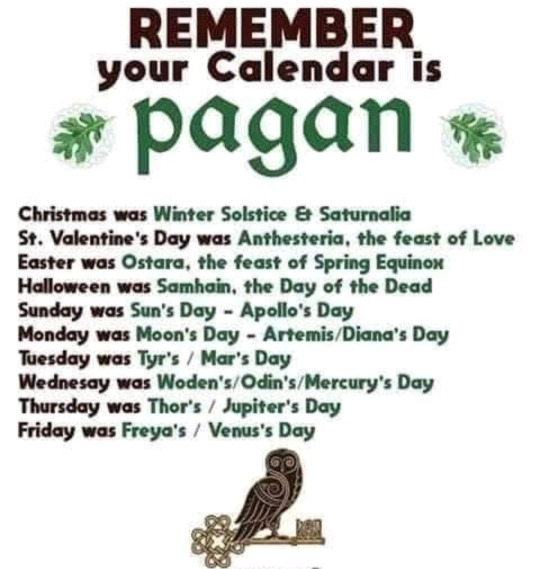
🖤✨
10 notes
·
View notes
Text

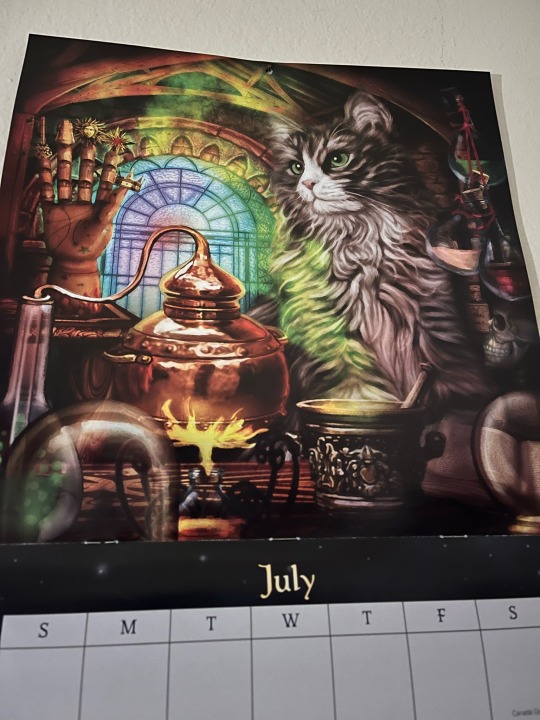
#they look like Obi#!!!!!!!#only fitting#birthday month#obi's twin other than ani#cat#druid#pagan calendar
6 notes
·
View notes
Text
2024 Witches' Calendar
For all my witches out there, here's a handy list of the 2024 dates for the solstices, quarter days, full and new moons, and special events. I've listed my sources at the bottom.
Dates and times for all events are calculated for Eastern Standard Time, USA, Northern Hemisphere. Adjust for your location as needed and check the DarkSky Placefinder to see what special events will be visible in your area. Enjoy!
Solstices, Harvests, and Quarter Days
February 1-2 - Imbolc / Candlemas
March 19 - Spring Equinox / Ostara
April 30-May 1 - Beltane / May Day
June 20 - Summer Solstice / Midsummer / Litha
August 1 - Lughnasadh / Lammas / Summer Harvest
September 22 - Autumn Equinox / Mabon / Fall Harvest
October 31 - Samhain / Halloween / Final Harvest
December 21 - Winter Solstice / Yule
Full Moons
January 25 - Wolf Moon ♌
February 24 - Snow Moon ♍
March 25 - Worm Moon ♎
April 23 - Pink Moon ♏
May 23 - Flower Moon ♐
June 21 - Strawberry Moon ♑
July 21 - Thunder Moon (aka Buck Moon) ♑
August 19 - Sturgeon Moon* ♒
September 17 - Harvest Moon* ♓
October 17 - Hunter's Moon (aka Blood Moon)* ♈
November 15 - Frost Moon (or Beaver Moon)* ♉
December 15 - Cold Moon ♊
*- Supermoon
Fun Fact: The title of Harvest Moon is given to either the September or October full moon, whichever falls closest to the autumn equinox. Once again this year, that month will be September.
New Moons
January 11 ♑
February 9 ♒
March 10 ♓
April 8 ♈
May 7 ♉
June 6 ♊
July 5 ♋
August 4 ♌
September 2 ♍
October 2 ♎
November 1 ♏
December 1 ♐
December 30 (black moon) ♑
Special Celestial Events
January 3-4 - Quadrantids meteor shower peak
March 25 - Penumbral Lunar Eclipse
April 8 - Total solar eclipse
April 22-23 - Lyrids meteor shower peak
May 6-7 - Eta Aquarids meteor shower peak
August 11-13 - Perseids meteor shower peak
August 19 - Sturgeon Supermoon / Seasonal Blue Moon
September 17 - Harvest Supermoon / Penumbral Lunar Eclipse
October 2 - "Ring of Fire" solar eclipse
October 17 - Hunter's Supermoon
October 21-22 - Orionids meteor shower peak
November 15 - Frost Supermoon
November 16-17 - Leonids meteor shower peak
December 13-14 - Geminids meteor shower peak
December 30 - Black Moon
(Check the DarkSky Placefinder to see what will be visible in your area!)
Mercury Retrogrades (in case you need them)
April 1 - April 24
August 4 - August 27
November 25 - December 15
Happy Witching!
SOURCES & FURTHER READING:
Bree's Lunar Calendar Series
Bree's Secular Celebrations Series
Moon Info - Full Moon Dates for 2024
Calendar-12 - 2024 Moon Phases
Full Moonology - 2024 Full Moon Calendar
AstroStyle - All the 2024 Full Moons
Your Zodiac Sign - Astrology Calendar 2024
Old Farmer's Almanac - Mercury Retrograde Dates 2023-2024
Lonely Planet - Best Star-gazing Events of 2024
Sea and Sky - Astronomy Calendar of Celestial Events 2024
DarkSky International - Dark Sky Placefinder for Stargazing
Pagan Grimoire - Wheel of the Year: The 8 Festivals in the Wiccan Calendar (2024 Edition)
=
If you're enjoying my content, please feel free to drop a little something in the tip jar or check out my published works on Amazon or in the Willow Wings Witch Shop. 😊
EDIT: Mercury is stationed direct on Jan 1st, 2024. The source I used which stated it was in retrograde until the 18th had a typo.
EDIT: Fixed the zodiac signs for the full moons using a new source.
#witchcraft#witchblr#pagan#calendar#2024#full moon#new moon#lunar magic#astrology#mercury retrograde#WOTY#holidays
4K notes
·
View notes
Text
2024 Witch's Calendar

January
11th: New Moon
25th: Full Moon (Cold Moon)
February
2nd: Imbolc
9th: New Moon
24th: Full Moon (Quickening Moon)
March
10th: New Moon
19th: Ostara / Spring Equinox
25th: Full Moon (Storm Moon) / Lunar Eclipse
April
1st: Mercury Retrograde
8th: New Moon / Solar Eclipse
22nd: Earth Day
23rd: Full Moon (Wind Moon)
25th: Mercury Direct
May
1st: Beltane/May Day
7th: New Moon
23rd: Full Moon (Flower Moon)
June
6th: New Moon
20th: Litha / Summer Solstice
21st: Full Moon (Strong Sun Moon)
July
2nd: New Moon
21st: Full Moon (Blessing Moon)
August
1st: Lammas/Lughnasadh
4th: New Moon
5th: Mercury Retrograde
19th: Full Moon (Corn Moon)
28th: Mercury Direct
September
2nd: New Moon
17th: Full Moon (Harvest Moon) / Lunar Eclipse
22nd: Mabon / Fall Equinox
October
2nd: New Moon / Solar Eclipse
17th: Full Moon (Blood Moon)
31st: Samhain
November
1st: New Moon
15th: Full Moon (Mourning Moon)
25th: Mercury Retrograde
December
1st: New Moon
15th: Full Moon (Long Nights Moon) / Mercury Direct
21st: Yule / Winter Solstice
30th: New Moon
#pagan#witchcraft#paganism#witch#occult#wicca#dark#magick#neopagan#wiccan#witchblr#witches of tumblr#2024#calendar#2024 calendar#witchy#witchy stuff#witchy shit#witchy tips#witchyvibes#witchythings#witchcore
3K notes
·
View notes
Photo

Hello witches!
I bring you the 2023 calendar for the remaining months ☆゚. * ・ 。゚
How are you holding up mid-mercury retrograde?
This year I just added the Planet Oppositions because there are a few of them in the later months of the year and I wanted to research them.
This is a Northern Hemisphere calendar and specific dates may vary due to different time zones, so always do your research for your specific region.
And if you find any mistakes or anything do add it if you reblog, so I can keep it in mind for future calendars!
See you in the full moon!!
#witches calendar#moon#witch#witchcraft#wheel of the year#pagan#new moon#full moon#zodiac signs#sun#witchystuff#beltane#samhain#calendar 2023#2020#planets#potion#spell
1K notes
·
View notes
Text

#pagan#spiritual healing#healing#spirituality#nature#paganism#self care#altars#lunar witch#black witches#lunar calendar#moon phases#moon witch#black witch#pagans of color#paganlife#pagan life#spiritual community#spiritual practitioner#holistic practitioner
277 notes
·
View notes
Text
The Lunar Calendar
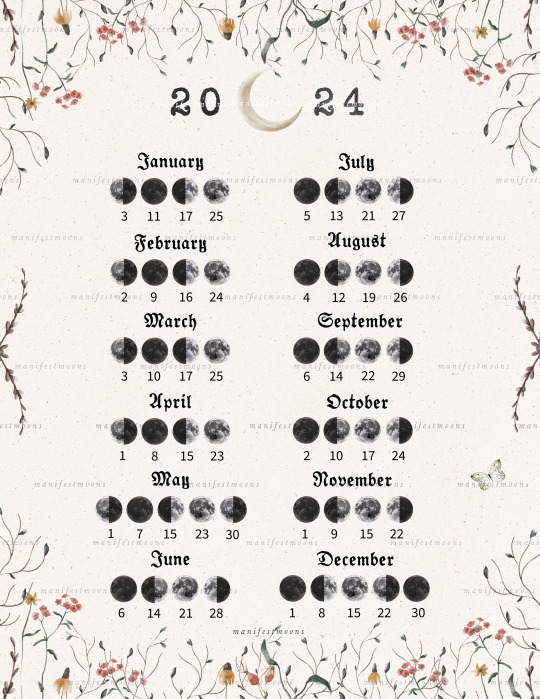
Using a lunar calendar involves tracking and utilizing the phases of the moon for various purposes. Here's how you can use a lunar calendar:
Understanding the Moon Phases: Familiarize yourself with the eight primary phases of the moon: New Moon, Waxing Crescent, First Quarter, Waxing Gibbous, Full Moon, Waning Gibbous, Last Quarter, and Waning Crescent.
Setting Intentions and Goals: Each moon phase represents a different energy. New Moon is ideal for setting intentions, while Full Moon is a time for culmination and realization.
Manifestation and Planning: Plan important events, projects, or rituals aligned with the corresponding moon phase. For example, start new projects during the Waxing Crescent for growth or release unwanted habits during the Waning Moon.
Spiritual and Personal Practices: Use specific moon phases for spiritual practices like meditation, reflection, and manifestation. Many people find rituals such as charging crystals or performing moon-related ceremonies more potent during certain phases.
Gardening and Nature-Based Activities: Use the moon phases for gardening by planting seeds during the Waxing Moon for optimal growth and pruning during the Waning Moon.
Emotional Awareness: Pay attention to how the moon phases affect your emotions, energy levels, and sleep patterns. Understanding these patterns can help align activities with your natural rhythms.
Maintaining a Lunar Calendar: Keep track of the moon phases using a lunar calendar. Mark important dates and phases to assist with planning and intention-setting.
Remember, while the lunar calendar can offer guidance, personal experiences and interpretations of the moon's phases vary. Experiment with different practices to see what resonates best with you and brings you closer to your goals.
#witchblr#lunar magic#witchcraft#manifestmoons#wicca#witchcraft basics#astrology#witch community#2024 calendar#ritual#pagan#law of attraction#moon magic#celestial#witches of tumblr#witch art#pagan witch#beginner witch#grimoire pages#cosmic witch#witchcraft 101#witchythings#green witch#hedge witch#kitchen witch#eclectic witch#witch history#zodiac signs#astrology community#astroblr
223 notes
·
View notes
Text
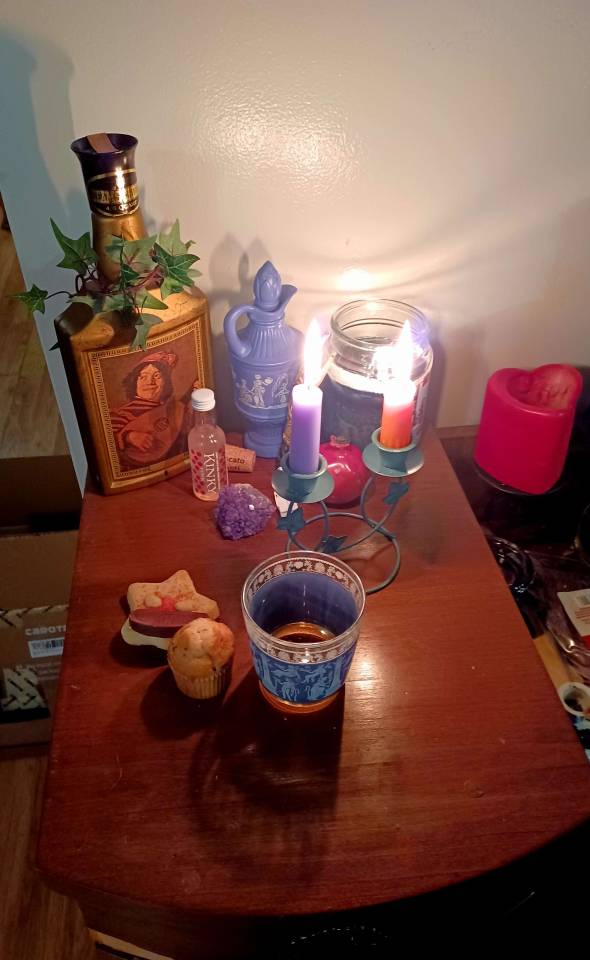

Happy New Year and Happy Rural Dionysia! Dionysus says make shit happen this year.
#hellenic polytheism#rural dionysia#dionysus#Attic calendar#helpol#dionysus worship#hellenic pagan#devotional post#my posts#altar
177 notes
·
View notes
Text
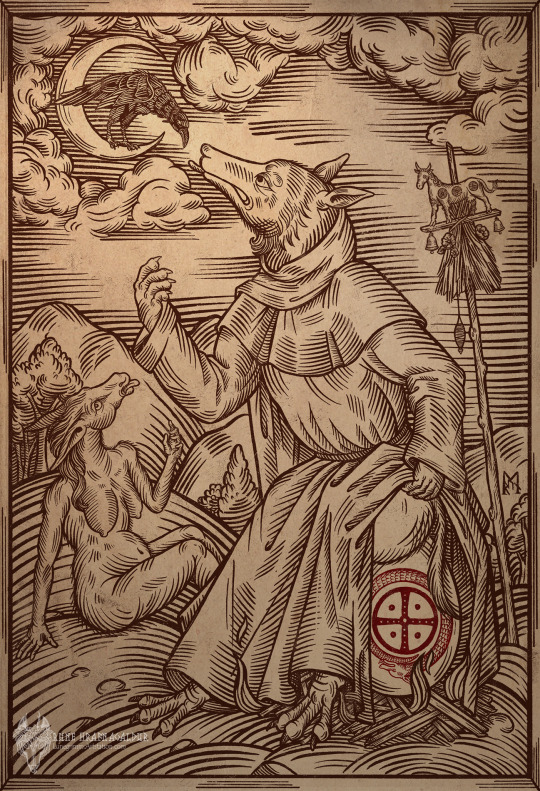

"The witches giving birth to summer"
Personal piece from earlier this year, Summer is already drawing to a close so decided to quickly post it now before autumn is in full swing :)
#art#artists on tumblr#digitalart#lunegrimmart#creature#medievalart#woodcut#anthro#animal art#animal calendar marker#animal calender#witch#witchers#sepent#solar#pagan#folklore#folklore art#fantasy#animist#animism#animist calendar#fire#egg#mule#witch art#dark art#dark fantasy#raven#night
263 notes
·
View notes
Text
Resources for Those Wanting to Learn about Pre-Christian Time Reckoning in Northern Europe and its Application in Modern Heathen Traditions
Throughout the history of the modern Neo-Pagan movement, the calendar that has been used by most practitioners has been either the Wiccan Wheel of the Year or another calendar heavily influenced by it. The Wheel of the Year draws largely upon a mixture of Celtic (Gaelic) and Anglo-Saxon traditions, splitting the years into quarters with quarterly and cross-quarterly celebrations and beginning the year at the end of October with the originally Gaelic festival of Samhain.
The calendars that have come to be popular for the majority of the modern Heathenry movement have undoubtedly been based in this calendar, with the major changes being to the names of certain celebrations. On the calendar created by Stephen McNallen for the AFA, Lammas became Freyfaxi, Mabon became Winter Finding, Samhain became Winter Nights, etc. Other organizations such as Forn Sidr of America, The Ásatrú Community, etc. have created their own versions of the calendar as well, but at their roots they all exist essentially as a modification of the Wheel of the Year concept.
More (relatively) recent research and scholarship has brought a greater awareness of older time reckoning systems within Heathen circles as well as amongst history enthusiasts. Some of this has focused on the Old Icelandic calendar as well as the primstav tradition, and while both of these have validity to them the Old Icelandic calendar already had some changes to how it worked from the older system and the primstav used a standardized dating system based in the Julian calendar. Still, these are both useful tools in attempting to reconstruct the pre-Christian (or at least pre-Julian) calendar systems of the Germanic, and particularly Scandinavian, peoples of Northern Europe.
Why is this at all important in an age with the Gregorian calendar used most everywhere and especially for those outside of Scandinavia? Because for those trying the build an understanding of or relationship with these cultures, or even just more connected to the earth in general, the way they reckoned time helps to understand their relationship and connection to their environment, the flow of seasons, how they viewed the different parts of the year and adjusted their activities accordingly, etc. It helps to understand the "why" behind the ritual cycle, even in the names of the months themselves.
Below are a few of the primary resources that I have found helpful in learning about these topics, as well as a graphic representation that I have made based on my research so far to represent the reconstructed Old Norse lunisolar calendar. Note that I don't claim to be an expert on this topic, so I could certainly be wrong in some of the details, and some of the months also have multiple names from which I chose one to use. Also, there were multiple time reckoning systems in use during the period, including a week-counting system, so there can also be conflicting information depending on which is being considered.
Sources:
"Jul, disting och förkyrklig tidräkning: Kalendrar och kalendriska riter i det förkristna Norden" by Andreas Nordberg
- Available as a free PDF, the majority of this is written in Swedish, but it contains a fairly concise English summary at the end. It focuses primarily on Old Norse Jól (Yule) as well as the Dísaþing/Disting and Dísablót in Sweden, but it touches on other celebrations and uses these to establish the overall scheme of the lunisolar calendar system.
"The Festival Year: A Survey of the Annual Festival Cycle and Its Relation to the Heathen Lunisolar Calendar" by Josh Rood
-Also available as a free PDF, this paper expands upon Norberg's work as well as others' and goes through the overall festival year of the pre-Christian Scandinavians.
"The Lunisolar Calendar of the Germanic Peoples: Reconstruction of a bound moon calendar from ancient, medieval and early modern sources" by Andreas Zautner
-This book is sort of a dive into a number of different ancient to early modern calendar systems, but it uses all of these to reconstruct lunisolar time reckoning systems not only for Scandinavians, but for other Germanic peoples as well. It's a great read for those interested in pre-Julian time reckoning in Northern Europe as well as Medieval calendar systems in general.
"The Nordic Animist Year" by Rune Hjarnø Rasmussen
-Similarly to Zautner's book, Rasmussen draws upon a variety of Medieval calendar systems in his work, but his goal, rather than reconstructing an Old Norse calendar is to create a modern calendar based in animist traditions of Northern Europe. It undoubtedly uses the lunisolar system as a base and takes a lot from Old Norse sources, but it also incorporates later traditions which are based in animist knowledge and have value in establishing a system of seasonal animism.
And lastly, my Old Norse lunisolar calendar representation. Each month starts on a new moon, represented by a black dot, and the festivals are shown at the full moons, being white dots. You may notice the lack of Þorrablót and Miðsumar (Midsommar) on here. Regarding Þorrablót, I'm not as well researched on the origins of it and how widespread it may have been. For Miðsumar I have long refrained from including it due to the absolute lack of mentions in literary material from during or shortly after the period, but I have been pointed to some instances of it marked on primstavs as July 14th (Julian calendar), suggesting a possible lunisolar observance of it earlier similar to Jól's relationship to the winter solstice.
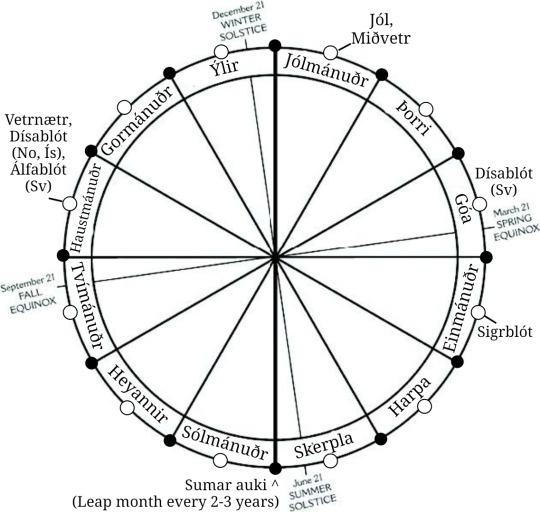
278 notes
·
View notes
Text
One of the reasons that my book of shadows focuses so much on the pagan/wiccan/Roman/etc... calendar is that I use witchcraft as a coping mechanism for my ADHD and anxiety.
I get a paralyzing feeling of dread when I am under pressure so I stop cleaning my house or accomplishing important tasks or feeding myself. I literally let my tooth rot until it fell out of my mouth on its own. I can get things done, but not the things I actually NEED to do.
So I use the ritual of witchcraft to help form traditions and habits that help me take care of myself!
Matronalia? Perfect time to do a breast exam
Kallynteria? Today is the day to vacuum the apartment in honor of Athena
It's a full moon? Take a fäncy bath, then scrub the tub or pick the clothes up off the bathroom floor!
Alfarblót? In honor, of the goddess Freya's chariot pulled by cats, I will get my oil changed.
It's kind of silly, but if I disguise actual tasks as silly things without any sense of pressure or immediacy and spread them out, I trick my brain into wanting to do them. And if that's not magic, I don't know what is.

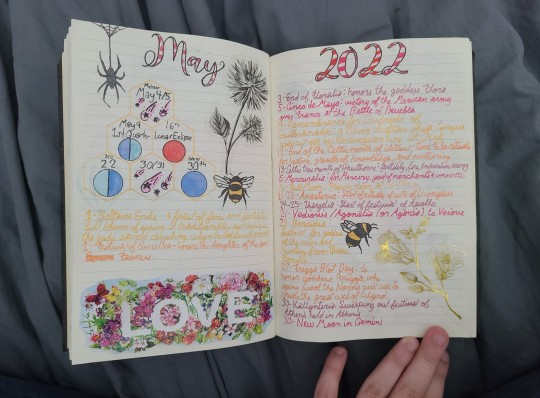
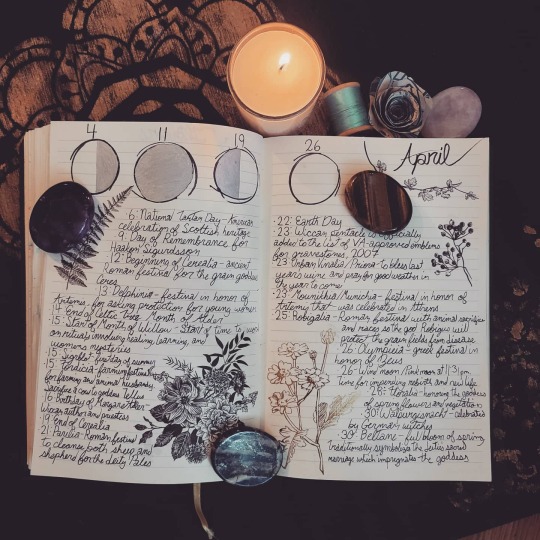
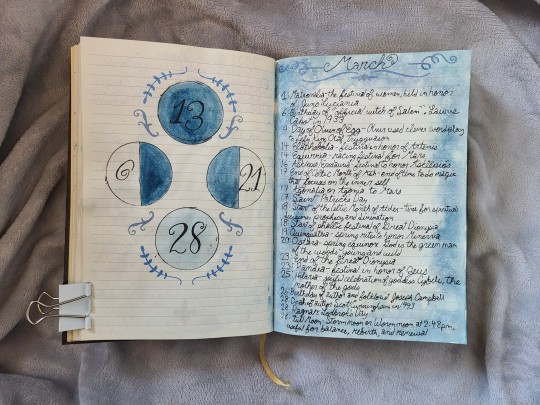
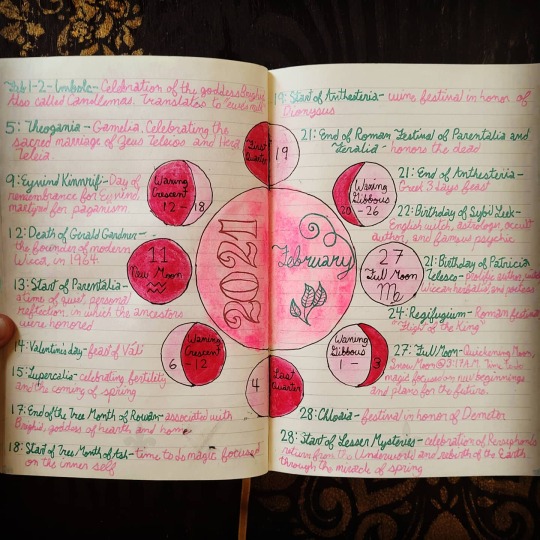
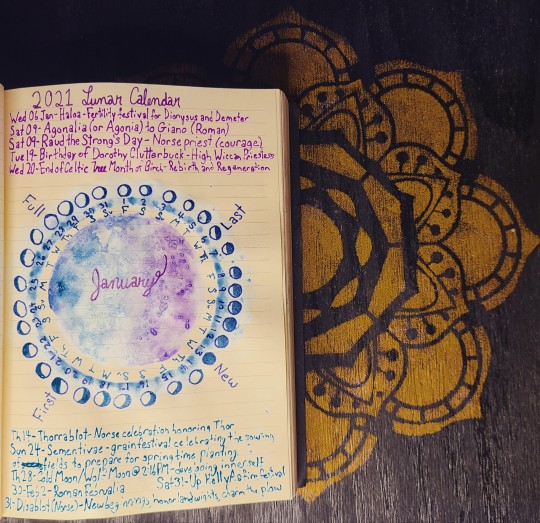
#witchcraft#witchblr#adhd#book of shadows#grimoire#pagan#witch#witches#witchcore#cryptidcore#wheel of the year#baby witch#viking#roman#grimoire pages#book of shadows pages#lunar calendar#i am diagnosed and i am NOT suggesting this instead of traditional medicine#obviously if i could afford to go back on medication i would but i cant so im doing my best 🤷♀️#not necessarily thriving but surviving
777 notes
·
View notes
Text
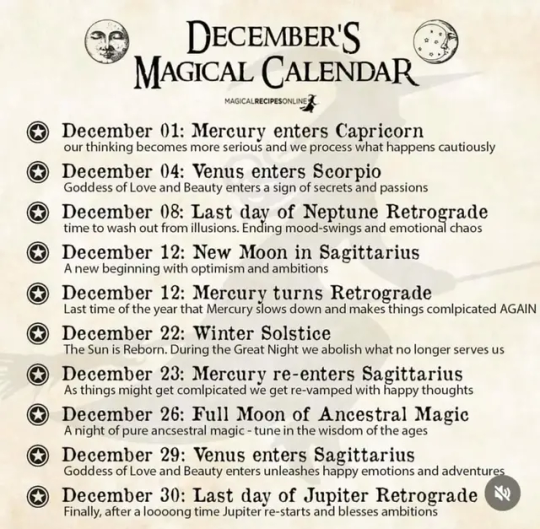
❄️🌒🌕🌘❄️
#khajiit metaphysical#stolen from facebook#witchblr#witchcraft#witch#cottagecore#witchcore#december#magical calendar#December calendar#pagan#paganblr#pagan witch#paganism#pagancore#astrology#astrological calendar#2023
41 notes
·
View notes
Text
2023 Witch's Calendar
For all my witches out there, here's a handy list of the 2023 dates for the major holidays, full and new moons, and special events. I've listed my sources at the bottom. Dates and times for all events are calculated for Eastern Standard Time, USA, Northern Hemisphere. Adjust for your location as needed. Enjoy!
WOTY Holidays and Solstices
February 1-2 - Imbolc
March 20 - Spring Equinox / Ostara
May 1 - Beltane
June 21 - Summer Solstice / Midsummer
August 1 - Lughnasadh
September 23- Autumn Equinox / Mabon
October 31 - Samhain
December 21 - Winter Solstice / Yule
Full Moons
January 6 - Wolf Moon ♋
February 5 - Snow Moon ♌
March 7 - Worm Moon ♍
April 6 - Pink Moon ♎
May 5 - Flower Moon ♏
June 4 - Strawberry Moon ♐
July 3 - Thunder Moon (aka Buck Moon) ♑
August 1 - Sturgeon Moon ♒
August 31 - Blue Moon ♓
September 29- Harvest Moon ♈
October 28 - Hunter's Moon (aka Blood Moon) ♉
November 27 - Frost Moon ♊
December 26 - Cold Moon ♋
Fun Fact: The title of Harvest Moon is given to either the September or October full moon, whichever falls closest to the autumn equinox. In 2023, as in 2022, that month will be September.
New Moons
January 21 ♒
February 20 ♓
March 21 ♈
April 20 ♈
May 19 ♉
June 18 ♊
July 17 ♋
August 16 ♌
September 14 ♍
October 14 ♎
November 13 ♏
December 12 ♐
Special Events
February 20 - 2nd New Moon in lunar month
April 20 - Solar Eclipse
May 5 - Penumbral Lunar Eclipse
August 30 - Blue Moon
September 29 - Penumbral Lunar Eclipse
October 14 - Solar Eclipe (Annular)
October 28 - Lunar Eclipse (Partial)
Mercury Retrogrades (in case you need them)
Dec 29, 2022 - Jan 18, 2023
April 21 - May 14
August 23 - September 15
Dec 13, 2023 - January 1, 2024
SOURCES:
Moon Info - Full Moon 2023
Calendar-12.com - Moon Phases 2023
Full Moonology - Full Moon Calendar 2023
Moon Calendar - Full Moons and New Moons in 2023
Yearly Horoscope - Mercury Retrograde 2023 Dates and Times
Your Zodiac Sign - 2023 Astrology Calendar
The Pagan Grimoire - The Wheel of the Year: The 8 Festivals in the Wiccan Calendar
=
If you're enjoying my content, please feel free to drop a little something in the tip jar or check out my published works on Amazon or in the Willow Wings Witch Shop. 😊
EDIT: Updated Jan 6, 2023 to correct full moon signs and include additional celestial events. Enjoy!
#Posting it early bc why not#witchcraft#pagan#witchblr#wicca#witch calendar#baby witch#witch tips#lunar calendar
5K notes
·
View notes